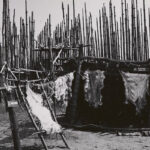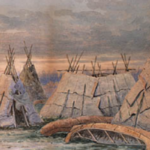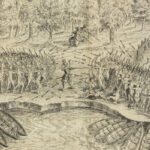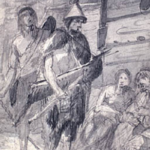Eskasoni First Nation: A Legacy of Resilience and Cultural Continuity
The Eskasoni First Nation, the largest Mi’kmaq community in Canada, is located on the shores of the Bras d’Or Lake in Cape Breton, Nova Scotia. As part of the Mi’kmaq Nation, Eskasoni’s story spans thousands of years, beginning in the pre-history of northeastern North America, through early encounters with European explorers, and into the modern era. This community is a testament to the resilience and adaptability of the Mi’kmaq people, who have maintained their cultural identity while navigating profound changes brought by colonization, industrialization, and modernization.
Pre-History: Mi’kmaq Origins and Connection to the Land
The Mi’kmaq, including the ancestors of the Eskasoni First Nation, have inhabited the lands of what is now Atlantic Canada for over 10,000 years. Archaeological evidence, including ancient tools, pottery, and burial sites, points to a rich and complex society deeply connected to the land and waters of the region. The Bras d’Or Lake, with its unique combination of salt and freshwater ecosystems, provided an abundance of resources that supported the Mi’kmaq’s semi-nomadic lifestyle.
The Mi’kmaq followed a seasonal cycle, spending summers along the coasts and lakeshores to fish for salmon, eel, and cod, and winters in the forests to hunt moose, caribou, and small game. This sustainable way of life was guided by Netukulimk, a principle of resource management that ensured the environment’s bounty was preserved for future generations. Their worldview, which saw all elements of nature as interconnected and imbued with spirit, was expressed through ceremonies, storytelling, and daily practices.
The name Eskasoni itself is derived from the Mi’kmaq word We’kwistoqnik, meaning “where the fir trees are plentiful.” This reflects the community’s deep connection to the forests and waterways that sustained them for millennia.
Governance and Social Structure
Traditional Mi’kmaq governance, including that of Eskasoni, was based on respect, consensus, and shared responsibility. Each community was led by a Sagamore (local chief), who worked closely with elders and other respected members to guide decisions on hunting, trade, and conflict resolution. The Mi’kmaq Grand Council, or Santé Mawiómi, served as a central governing body that united the various districts of Mi’kma’ki, ensuring peace and cooperation among the communities.
Kinship bonds were fundamental to Mi’kmaq society, fostering mutual support and collaboration. Oral traditions, passed down through generations, preserved the community’s history, spiritual teachings, and practical knowledge, ensuring that their cultural heritage remained intact even in times of upheaval.
First Contact with European Explorers
The arrival of European explorers and settlers in the 15th and 16th centuries marked a turning point for the Mi’kmaq, including those in Eskasoni. Early interactions were primarily with Basque and Breton fishermen who frequented the waters of the Atlantic coast and the Bras d’Or Lake for its rich fisheries. These encounters were largely transactional, with the Mi’kmaq trading furs for European goods such as metal tools, cloth, and beads.
The establishment of French settlements in the 17th century brought new opportunities and challenges. French explorers, including Samuel de Champlain, recognized the Mi’kmaq as valuable allies in navigating and surviving the land. The fur trade became a cornerstone of these relationships, with the Mi’kmaq playing a central role as trappers and intermediaries. However, the arrival of Europeans also introduced devastating diseases such as smallpox and measles, which decimated Indigenous populations and disrupted their societies.
Relationships with Missionaries and Settlers
French missionaries, particularly the Jesuits, established missions among the Mi’kmaq during the 17th and 18th centuries. In Eskasoni and surrounding areas, Catholicism became intertwined with Mi’kmaq spiritual practices, leading to a unique syncretism that blended traditional beliefs with Christian teachings. The Mi’kmaq of Eskasoni adopted elements of Christianity while retaining their cultural identity, reflecting their ability to adapt to changing circumstances without losing their sense of self.
The Mi’kmaq often allied with the French during conflicts with the British, including the Seven Years’ War (1756–1763). These alliances were based on mutual interests, as the French provided goods and military support while the Mi’kmaq offered their knowledge of the land and waterways. However, the British victory in 1763 led to increased pressures on Mi’kmaq lands and autonomy.
The 19th and 20th Centuries: Challenges and Resilience
The 19th century brought profound changes to Eskasoni and other Mi’kmaq communities. The imposition of the Indian Act (1876) and the establishment of reserves confined the Mi’kmaq to smaller parcels of land, disrupting their traditional ways of life. For Eskasoni, this meant adapting to life on the Bras d’Or Lake while facing restrictions on hunting, fishing, and mobility.
Despite these challenges, the people of Eskasoni demonstrated remarkable resilience. Fishing remained a central part of their economy and culture, with the Bras d’Or Lake continuing to provide sustenance and a connection to their ancestors. Traditional crafts such as basket-making and beadwork became important sources of income and cultural expression.
The residential school system, which aimed to assimilate Indigenous children by severing their ties to their language and culture, caused significant trauma for the community. However, the elders of Eskasoni played a crucial role in preserving Mi’kmawi’simk, the Mi’kmaq language, and in passing down cultural traditions through storytelling, ceremonies, and seasonal practices.
Cultural Revitalization and Environmental Stewardship
In recent decades, Eskasoni has been at the forefront of cultural revitalization and environmental stewardship. Language programs have been established to ensure the survival of Mi’kmawi’simk, which remains a living language spoken by many community members. Cultural workshops, including traditional drumming, dancing, and crafting, have fostered a renewed sense of pride and unity within the community.
Environmental stewardship has also been a central focus for Eskasoni. The Bras d’Or Lake, a UNESCO Biosphere Reserve, is integral to the community’s identity and well-being. Efforts to restore salmon populations, improve water quality, and protect habitats reflect Eskasoni’s commitment to preserving their natural heritage for future generations.
Eskasoni Today: A Thriving Community
Today, the Eskasoni First Nation is a vibrant and dynamic community of over 4,000 members, making it the largest Mi’kmaq community in Canada. Investments in education, healthcare, and economic development have transformed Eskasoni into a model of self-sufficiency and cultural resilience. The community has embraced cultural tourism, with attractions such as the Eskasoni Cultural Journeys, offering visitors an opportunity to learn about Mi’kmaq history and traditions.
The annual Eskasoni Powwow is a highlight of the cultural calendar, bringing together people from across Mi’kma’ki to celebrate their heritage through drumming, dancing, and storytelling. This event not only strengthens community bonds but also serves as a powerful reminder of the enduring strength and vitality of Mi’kmaq culture.
Conclusion: A Legacy of Strength and Continuity
The history of the Eskasoni First Nation is a testament to the resilience, adaptability, and cultural richness of the Mi’kmaq people. From their ancient presence in Unama’ki to their pivotal role in early European trade and their modern achievements in cultural and environmental stewardship, Eskasoni has remained a beacon of strength and continuity.
As an elder from Eskasoni once said, “Our land and our language are our heart and soul. By protecting them, we honour our ancestors and build a future for our children.”
References
- Whitehead, Ruth Holmes. The Old Man Told Us: Excerpts from Micmac History, 1500–1950. Nimbus Publishing, 1991.
- Jesuit Relations. Documents of the Missions to New France. McGill University Press, 1962.
- Conrad, Margaret. A Concise History of Canada. Cambridge University Press, 2012.
- Eskasoni Cultural Journeys. A Journey Through Time: The History and Culture of Eskasoni. Eskasoni Publications, 2018.
- Ridington, Robin. Trail to Heaven: Knowledge and Narrative in a Northern Native Community. Douglas & McIntyre, 1988.
- Environmental Justice Advocacy Group. Stewardship and Sovereignty: Indigenous Environmental Leadership in Canada. University of Guelph Press, 2019.
- Johnston, Basil. Ojibway Heritage. McClelland & Stewart, 1976.
- Mi’kmaq Grand Council. Santé Mawiómi: Traditions and Governance of the Mi’kmaq Nation. Halifax Press, 1985.
- Snow, Dean R. The Iroquois. Blackwell, 1994.
- Neeposh, Thomas. “Protecting Our Future: The Vision of Eskasoni First Nation.” CBC News, 2021.



